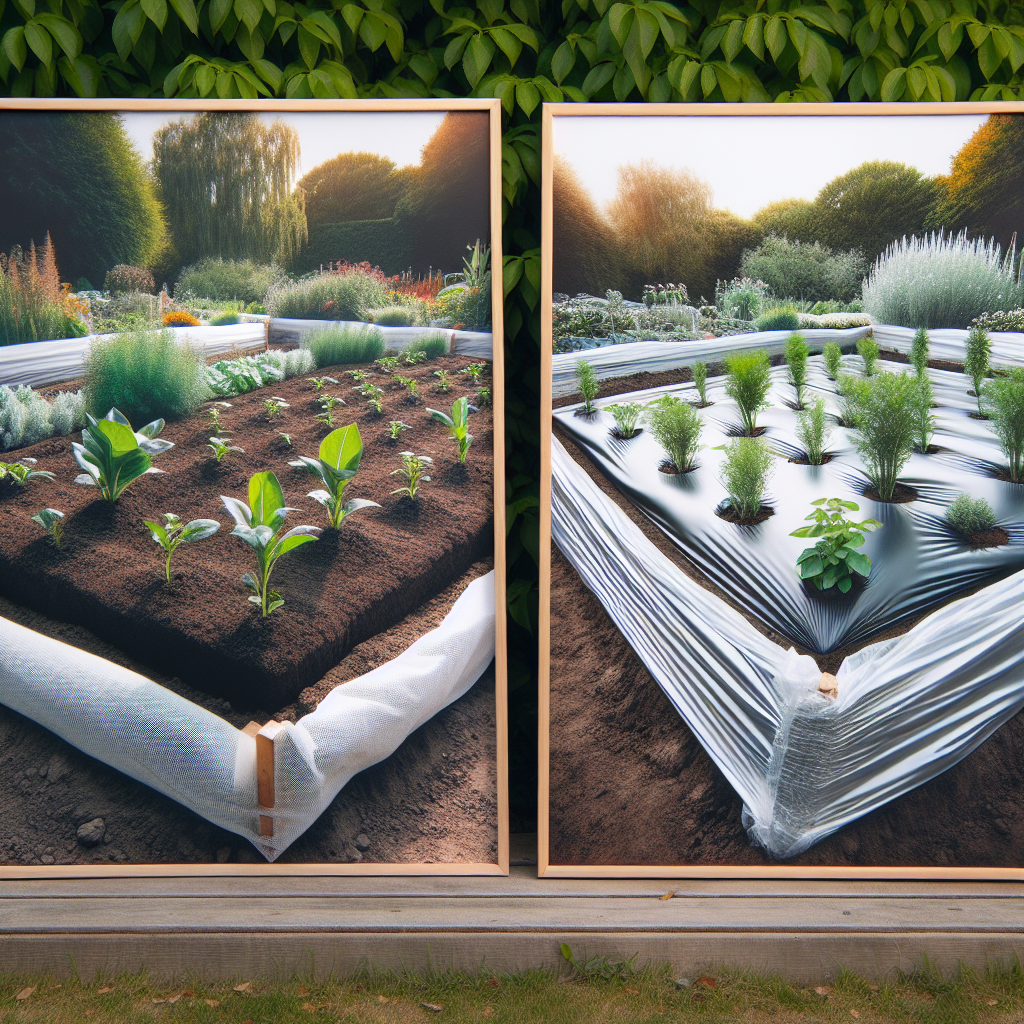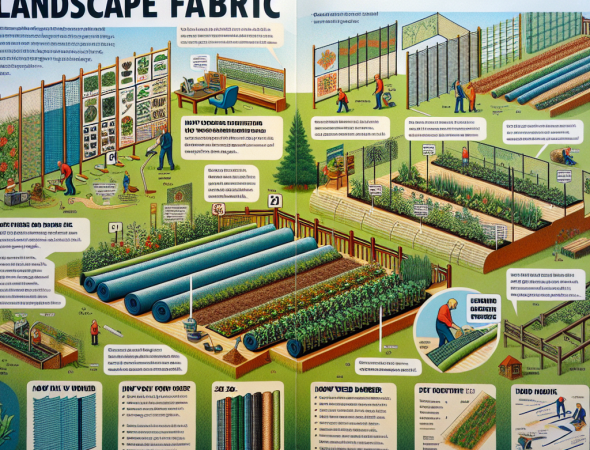Landscape Fabric vs. Plastic Sheeting: Which Lasts Longer for Garden Beds?
Landscape Fabric Durability: Pros and Cons
When considering the durability of landscape fabric for garden beds, it is essential to weigh its advantages and disadvantages. Landscape fabric, often made from woven or non-woven polypropylene, is designed to provide a barrier against weeds while allowing water and nutrients to penetrate the soil. One of the primary benefits of landscape fabric is its longevity. Typically, high-quality landscape fabric can last anywhere from five to twenty years, depending on the environmental conditions and the specific product used. This durability makes it an appealing choice for gardeners looking to minimize maintenance and reduce the frequency of replacement.
Moreover, landscape fabric is relatively easy to install. It can be cut to fit various garden shapes and sizes, allowing for flexibility in design. Once laid down, it can be covered with mulch or soil, which not only enhances the aesthetic appeal of the garden but also helps to secure the fabric in place. Additionally, the permeability of landscape fabric is a significant advantage. Unlike plastic sheeting, which can create a barrier that prevents water and air from reaching the soil, landscape fabric allows for adequate drainage and aeration. This characteristic is crucial for maintaining healthy soil and promoting plant growth, as it prevents waterlogging and encourages beneficial microbial activity.
However, despite its many advantages, landscape fabric is not without its drawbacks. One notable concern is that over time, the fabric can become clogged with soil, organic matter, and weed seeds. This clogging can diminish its effectiveness in preventing weed growth, necessitating periodic maintenance to ensure that the fabric remains functional. Furthermore, while landscape fabric is designed to be durable, it is not impervious to damage. Exposure to UV rays can degrade the material over time, leading to tears and reduced effectiveness. Consequently, gardeners must consider the specific conditions of their environment, as prolonged exposure to sunlight can significantly impact the lifespan of the fabric.
Another consideration is the cost. While landscape fabric is generally more affordable than some alternatives, such as plastic sheeting, the initial investment can still be a factor for budget-conscious gardeners. Additionally, the need for periodic replacement or maintenance can add to the overall cost over time. Therefore, it is essential to evaluate not only the upfront expense but also the long-term implications of using landscape fabric in a garden setting.
In contrast to landscape fabric, plastic sheeting offers a different set of advantages and disadvantages. While it can provide a more effective barrier against weeds in the short term, its lack of permeability can lead to issues with soil health and drainage. As such, gardeners must carefully consider their specific needs and the long-term implications of their choice. Ultimately, the decision between landscape fabric and plastic sheeting hinges on various factors, including the desired longevity, maintenance requirements, and environmental conditions.
In conclusion, landscape fabric presents a durable option for garden beds, with its ability to balance weed control and soil health. However, its effectiveness can diminish over time due to clogging and UV degradation. Therefore, gardeners must weigh these pros and cons against their specific gardening goals and conditions to make an informed decision that best suits their needs.
Plastic Sheeting Longevity: Benefits and Drawbacks

When considering the longevity of materials used in garden beds, plastic sheeting emerges as a popular option due to its unique properties and versatility. One of the primary benefits of plastic sheeting is its durability. Made from polyethylene or similar materials, plastic sheeting is designed to withstand various environmental conditions, including moisture, UV exposure, and temperature fluctuations. This resilience allows it to maintain its structural integrity over extended periods, often lasting several years when properly installed and maintained. Consequently, gardeners often find that plastic sheeting can serve as an effective barrier against weeds, pests, and soil erosion, contributing to a healthier garden ecosystem.
Moreover, the impermeability of plastic sheeting offers significant advantages in moisture management. By creating a barrier that prevents water from seeping through, it helps retain soil moisture, which can be particularly beneficial in arid climates or during dry seasons. This moisture retention not only supports plant health but also reduces the frequency of watering, thereby conserving water resources. Additionally, the use of plastic sheeting can help regulate soil temperature, creating a more stable environment for root development. This temperature control can be especially advantageous for seedlings and young plants, which are often more sensitive to extreme fluctuations.
However, despite these benefits, there are notable drawbacks to using plastic sheeting in garden beds. One significant concern is its environmental impact. Plastic is a non-biodegradable material, which means that once it reaches the end of its useful life, it can contribute to landfill waste and environmental pollution. Furthermore, over time, exposure to sunlight can cause plastic sheeting to degrade, leading to brittleness and eventual tearing. This degradation not only shortens its lifespan but can also result in microplastics entering the soil, potentially affecting soil health and plant growth.
Another drawback is the potential for waterlogging. While plastic sheeting effectively retains moisture, it can also prevent excess water from draining away, leading to saturated soil conditions. This waterlogging can create an environment conducive to root rot and other plant diseases, ultimately harming the very plants the sheeting was intended to protect. Therefore, careful consideration must be given to drainage solutions when using plastic sheeting in garden beds.
In addition to these concerns, the aesthetic aspect of using plastic sheeting cannot be overlooked. Many gardeners prefer the natural look of organic materials, and plastic sheeting can detract from the visual appeal of a garden. This aesthetic consideration may lead some gardeners to seek alternative solutions that align more closely with their design preferences.
In conclusion, while plastic sheeting offers several advantages in terms of durability, moisture retention, and temperature regulation, it is essential to weigh these benefits against its environmental impact and potential drawbacks. Gardeners must consider their specific needs, the local climate, and the long-term implications of using plastic sheeting in their garden beds. By carefully evaluating these factors, one can make an informed decision that balances practicality with environmental responsibility, ultimately leading to a thriving and sustainable garden.
Comparative Analysis: Lifespan of Landscape Fabric vs. Plastic Sheeting in Garden Beds
When it comes to establishing and maintaining garden beds, the choice of materials can significantly impact the longevity and health of the plants. Among the various options available, landscape fabric and plastic sheeting are two popular choices that gardeners often consider. Understanding the lifespan of these materials is crucial for making an informed decision that aligns with the specific needs of a garden.
Landscape fabric, typically made from woven or non-woven polypropylene, is designed to allow water and air to permeate while preventing weed growth. One of the primary advantages of landscape fabric is its durability; it can last anywhere from three to ten years, depending on the quality of the material and the environmental conditions in which it is used. For instance, high-quality landscape fabrics that are UV-stabilized tend to have a longer lifespan, as they are less susceptible to degradation from sunlight exposure. Additionally, the fabric’s ability to allow moisture and nutrients to reach the soil contributes to a healthier growing environment for plants, which can indirectly enhance the longevity of the garden bed itself.
In contrast, plastic sheeting, often made from polyethylene, serves a different purpose. While it effectively blocks weeds and retains soil moisture, it does not allow for air and water exchange in the same way that landscape fabric does. The lifespan of plastic sheeting can vary significantly, typically ranging from one to five years. Factors such as thickness, exposure to sunlight, and temperature fluctuations play a critical role in determining how long plastic sheeting will last. Thinner sheets may degrade more quickly, especially when exposed to harsh weather conditions, while thicker varieties may offer a bit more durability. However, the lack of permeability can lead to issues such as soil compaction and root rot, which can ultimately shorten the lifespan of the garden bed.
Moreover, the environmental impact of these materials should also be considered when evaluating their longevity. Landscape fabric is generally more environmentally friendly, as it is often made from recycled materials and can be more easily disposed of or recycled at the end of its life. On the other hand, plastic sheeting poses challenges in terms of disposal, as it is not biodegradable and can contribute to plastic pollution if not properly managed. This aspect of sustainability is increasingly important for gardeners who are conscious of their ecological footprint.
In terms of maintenance, landscape fabric may require occasional adjustments or replacements, particularly if it becomes clogged with soil or organic matter. However, its ability to support healthy plant growth can justify the effort. Conversely, while plastic sheeting may be easier to install initially, its potential for causing long-term soil health issues can lead to more significant problems down the line, necessitating more frequent replacements.
Ultimately, the choice between landscape fabric and plastic sheeting hinges on the specific goals of the gardener. If the primary objective is to create a sustainable and healthy growing environment that lasts several years, landscape fabric may be the superior option. However, for those seeking a quick and cost-effective solution for short-term weed control, plastic sheeting might suffice. By carefully considering the lifespan and implications of each material, gardeners can make a more informed decision that best suits their gardening practices and long-term goals.







Add comment